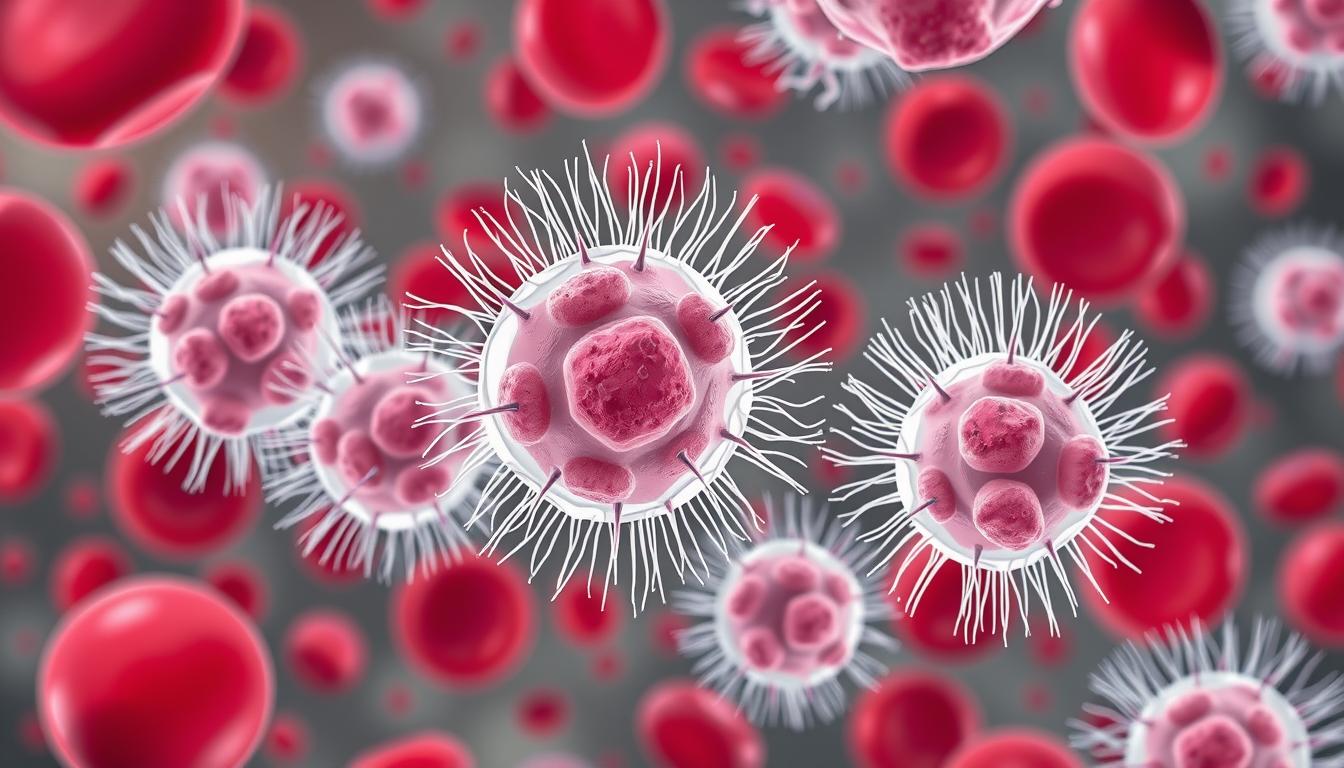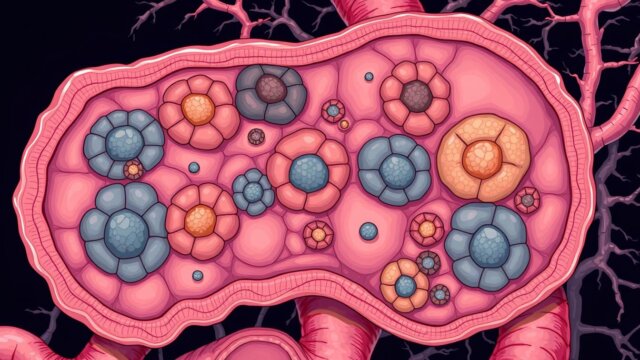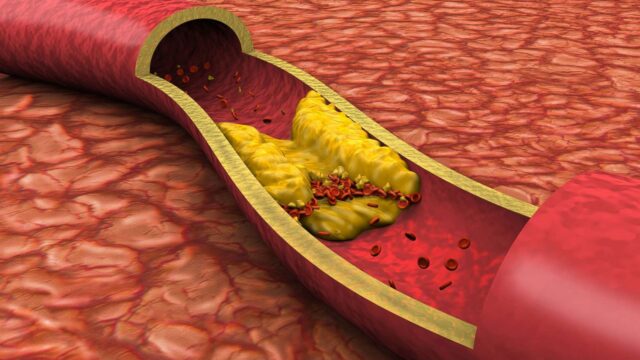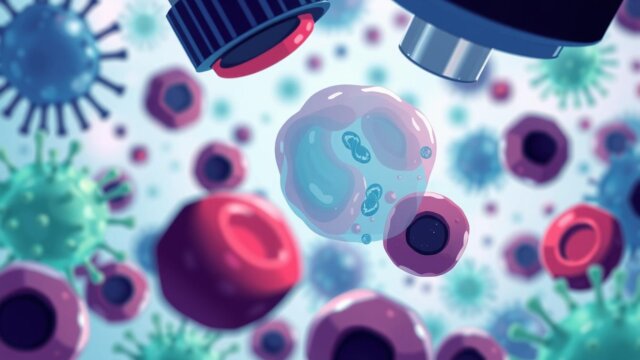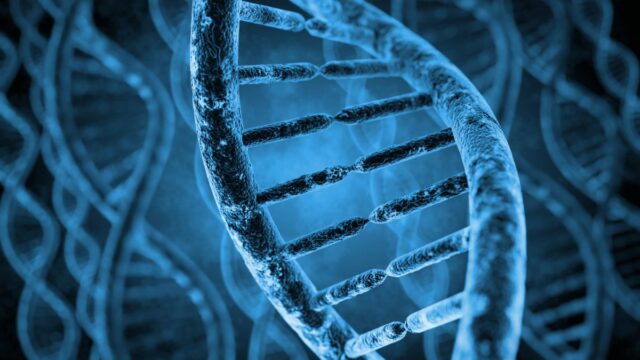FTC disclaimer: This post may contains affiliate links and we will be compensated if you click on a link and make a purchase.
Hairy cell leukemia is a rare blood cancer, making up only 2% of adult leukemia cases in the U.S.. It affects about 1,000 people each year. This cancer starts in memory B cells and spreads to the bone marrow, spleen, and liver.
It mostly hits older adults, especially those in their 50s and 60s. It’s also more common in men than women, but why isn’t it clear? People with this disease often feel tired, get sick easily, and have a big spleen.
Key Takeaways
- Hairy cell leukemia is a rare and chronic form of adult leukemia, affecting around 2% of adult leukemia cases in the United States.
- The malignant cells originate from the memory B cell compartment and infiltrate the bone marrow, spleen, and liver.
- Hairy cell leukemia is more likely to occur in older adults, with a higher prevalence in males compared to females.
- Symptoms may include fatigue, increased susceptibility to infections, and an enlarged spleen.
- Treatment for hairy cell leukemia typically involves chemotherapy, with the goal of achieving prolonged disease remission.
What is Hairy Cell Leukemia?
Hairy cell leukemia is a rare and chronic leukemia in adults. It starts in the memory B cell part of the body. The cancer cells spread to the bone marrow, spleen, and liver right away.
It starts slowly, causing tiredness, more infections, and a big spleen.
Characteristics of Hairy Cell Leukemia
The cancer cells look like hairs under a microscope. They have a special look that shows they are a unique type of B-cell cancer.
Prevalence and Demographics
Hairy cell leukemia is rare, making up 2% of adult leukemias. About 1,000 new cases happen each year in the U.S..
It mostly hits men, not women. People usually get it when they are 55 years old.
Statistic | Value |
|---|---|
Prevalence of Hairy Cell Leukemia | Approximately 2% of all adult leukemias |
New Cases Diagnosed Annually in the U.S. | Around 1,000 |
Gender Ratio | Predominantly affects men more than women |
Average Age at Diagnosis | 55 years old |
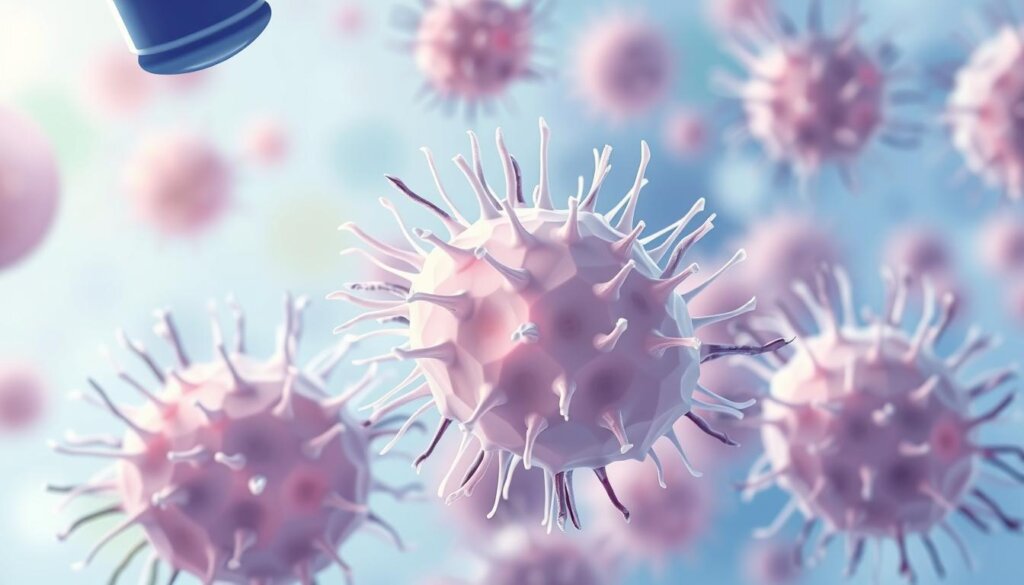
“Hairy cell leukemia is a rare and chronic form of adult leukemia, where the malignant cells are believed to originate from the memory B cell compartment.”
Diagnosis of Hairy Cell Leukemia
Diagnosing hairy cell leukemia starts with a check-up by your doctor. They first look for an enlarged spleen, seen in over 90% of patients. But, blood tests have made this symptom less common today.
Blood tests are key in finding the problem. A complete blood count (CBC) and a peripheral blood smear can spot hairy cells. Immunophenotyping, a test that looks at cell markers, confirms the diagnosis.
Bone Marrow Biopsy
The bone marrow biopsy is the main test for hairy cell leukemia. It takes a small bone marrow sample from the hip. This lets a pathologist check the bone marrow and hairy cells.
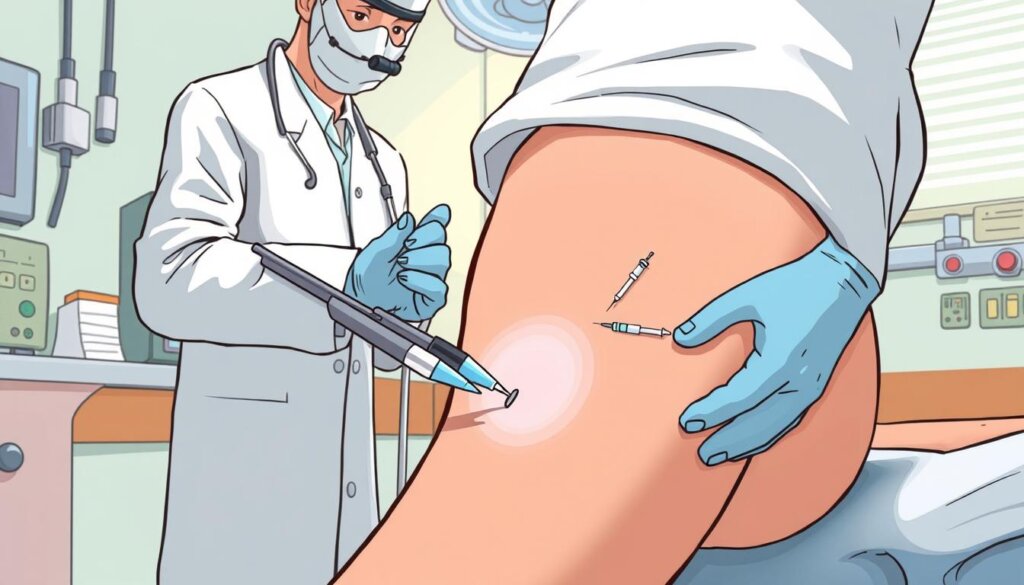
Your doctor might also do a CT scan to see if your spleen or lymph nodes are swollen. These tests help your healthcare team understand your condition and choose the best treatment.
“Consensus guidelines for the diagnosis and management of classic Hairy Cell Leukemia were published in 2017, indicating the importance of standardized approaches.”
Symptoms of Hairy Cell Leukemia
Hairy cell leukemia (HCL) can cause many symptoms. This is because it affects the bone marrow and other organs. People with HCL might bruise easily, sweat a lot, especially at night, and feel very tired.
They might also feel full quickly, get infections often, and have pain in their belly or swollen lymph glands. Weight loss is another symptom they might experience.
The bone marrow problems in HCL can lead to anemia and infections. It can also cause bleeding issues. The spleen and liver getting bigger can add to the pain and discomfort.
People with HCL might also get infections and autoimmune diseases. This is because their immune system is affected. It’s crucial to know these symptoms and see a doctor right away if they happen.

The symptoms of hairy cell leukemia can vary a lot from person to person. Knowing the signs and getting medical help early can help manage the disease. This way, people can take care of their health and address any concerns about this rare leukemia.
Effects of Bone Marrow Involvement
Hairy cell leukemia (HCL) is a rare blood cancer that mainly affects the bone marrow. The cancer cells in the bone marrow stop healthy blood cells from being made. This causes many problems.
These issues can really hurt a person’s health and happiness.
Anemia
Anemia is a big problem in HCL. It happens when there are fewer red blood cells. People with anemia from HCL often feel very tired and weak and have trouble breathing.
Increased Infection Risk
HCL also makes it harder for the body to fight off infections. This is because there are fewer white blood cells. So, people with HCL might get sick more often, like pneumonia or bronchitis.
Bleeding Complications
Finally, HCL can cause problems with blood clotting because of fewer platelets. This can lead to bleeding, like nosebleeds or gum bleeding, and even serious bleeding.
It’s very important to know how bone marrow involvement affects HCL. This helps patients and doctors manage the disease better and improve life quality.
Effect | Explanation |
|---|---|
Anemia | Decreased red blood cell production leads to fatigue, weakness, and shortness of breath. |
Increased Infection Risk | Decreased white blood cell production increases susceptibility to recurrent infections. |
Bleeding Complications | Decreased platelet production can cause nosebleeds, gum bleeding, and severe spontaneous bleeding. |
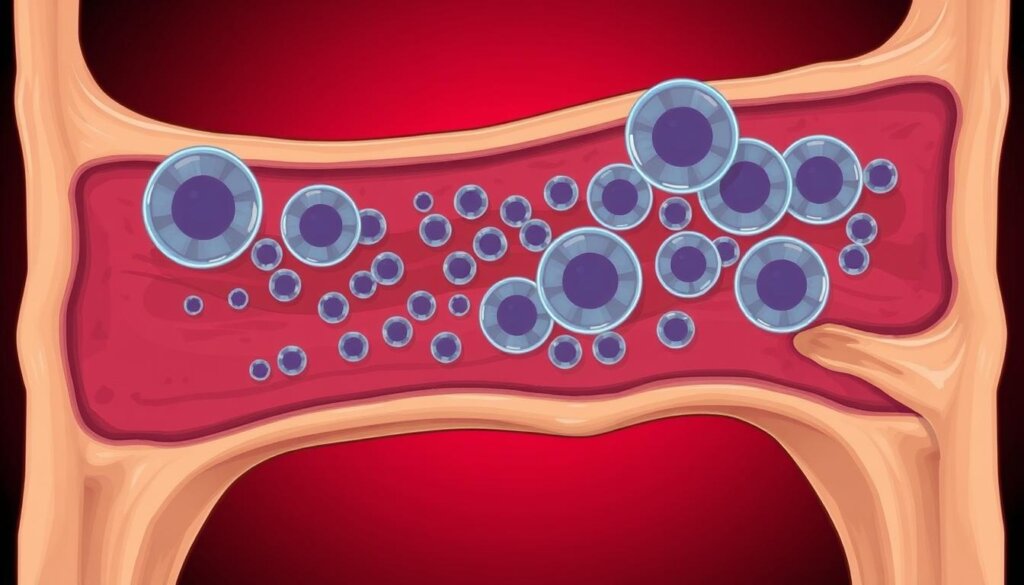
Knowing how bone marrow involvement affects HCL helps patients and doctors create a good treatment plan. This plan meets each person’s needs.
Organ Involvement
Hairy cell leukemia (HCL) can affect more than just the bone marrow and blood. It can also involve the spleen and liver. Over 90% of people with HCL have an enlarged spleen or splenomegaly.
This can cause discomfort and a feeling of fullness in the belly. In severe cases, it can lead to a lot of pain.
Liver Involvement
The liver can also be affected by hairy cells, leading to pain on the right side of the belly. It can also cause abnormal liver function tests and fluid buildup in the belly (ascites). Most HCL patients have hairy cells in their liver, but not all show symptoms.
The severity of liver involvement doesn’t always match the spleen size or other symptoms.
Hairy cells can also go to the bones, causing pain and damage. It’s important to check and watch for organ involvement in HCL patients.
In summary, hairy cell leukemia affects more than just the bone marrow and blood. It can also impact the spleen and liver. It’s key to monitor these areas to manage HCL well.
Secondary Complications
People with hairy cell leukemia often face extra problems because their immune system is weak. These issues can include infections and autoimmune diseases. These make life harder for those with this rare blood cancer.
Infections
One big problem is getting sick more easily. Hairy cell leukemia messes with the immune system. This makes patients more likely to get sick from fungi, viruses, and bacteria.
These sicknesses can show up in many ways. You might get skin rashes, pneumonia, liver issues, or brain swelling. Symptoms can be fever, cough, headaches, and feeling confused.
Autoimmune Diseases
Another issue is autoimmune diseases in up to one-third of patients. These happen when the immune system attacks healthy body parts. This leads to inflammation and problems in different parts of the body.
Autoimmune problems in hairy cell leukemia can cause joint pain, swelling, rashes, fever, and unintentional weight loss.
It’s important to deal with these secondary problems to keep people healthy. Regular doctor visits, quick treatment of infections, and watching for autoimmune issues are key. This helps improve life quality for those with hairy cell leukemia.
Hairy Cell Leukemia Treatment
Hairy cell leukemia is well-treated, thanks to new medicines in the 1980s. But, we can’t cure it yet. Doctors use different treatments to manage the disease.
When to Start Treatment
Doctors decide when to start treatment based on symptoms and blood counts. Some patients might watch their condition closely without treatment right away. This is called “active monitoring.”
Treatment Options
When treatment is needed, doctors use several methods:
- Chemotherapy: Drugs like cladribine, alone or with rituximab, work well for new patients.
- Immunotherapy: Rituximab helps those with hard-to-treat cases.
- Targeted Therapy: Vemurafenib, a BRAF inhibitor, works well, with an 86% to 98% response rate. Dabrafenib and trametinib also show great results together.
These treatments can cause the disease to go into remission for a long time. Even though it’s not curable, patients can live well with it. It’s important for patients to work with their doctors to find the best treatment.
“Hairy cell leukemia is one of the most successfully treated leukemias, with the advent of effective agents in the 1980s.” – HealthyIous
Hairy Cell Leukemia Prognosis
Hairy cell leukemia (HCL) is a slow-growing blood cancer. Many patients can live for years without needing treatment. When treatment is needed, it works well to make symptoms go away and show no cancer signs.
But, HCL often comes back, needing more treatment.
Even though HCL can’t be cured, with the right care, patients can live long and normal lives. New treatments like dabrafenib and rituximab help fight the disease back.
Thanks to new treatments, HCL patients have a better outlook now. Doctors have clear guidelines and trials to help manage the disease better.
HCL is a rare blood cancer with “hairy” cells. It often makes the spleen big and can lower blood counts. This can lead to anemia, bleeding, and infections.
What causes HCL is still a mystery, but some things might increase the risk. Things like pesticides and farming might play a part, but not smoking or drinking. Some cases might run in families.
Doctors first check to see how bad the disease is and how well the patient can handle treatment. Blood tests and physical exams are key to diagnosing HCL. They look for big spleens, livers, or lymph nodes.
Today, HCL patients have a better chance of long-term remission. But, they still need to watch out for relapse and get the right treatment.
Conclusion
Hairy cell leukemia is a rare cancer that affects adults. It starts in memory B cells and spreads to the bone marrow, spleen, and liver. The exact cause is still unknown, but it can be treated, even though it’s not curable.
Symptoms can include problems with the bone marrow, enlarged organs, and other issues. Finding the right treatment is key, and it starts with a correct diagnosis.
Doctors use physical checks, blood tests, and bone marrow biopsies to diagnose it. Hairy cell leukemia often gets better with treatment. But, it can come back, so patients need ongoing care from experts.
Thanks to new research, patients are living better with hairy cell leukemia. More awareness and research help doctors improve care for those with this rare cancer.
FAQ
What is hairy cell leukemia?
Hairy cell leukemia is a rare cancer in adults. It starts in the memory B cells. These bad cells spread to the bone marrow, spleen, and liver.
How common is hairy cell leukemia?
It’s a rare disease, making up 2% of adult leukemia cases. In the U.S., about 1,000 people get it each year. Men get it more often than women.
How is hairy cell leukemia diagnosed?
Doctors use a few tests to find it. They check your blood and do a bone marrow biopsy. This confirms the presence of “hairy cells.”
What are the symptoms of hairy cell leukemia?
Symptoms include anemia, infections, and bleeding. It also affects the spleen and liver. This can lead to more problems like infections and autoimmune diseases.
How does bone marrow involvement affect patients with hairy cell leukemia?
The disease harms the bone marrow. This leads to fewer red and white blood cells. It also causes bleeding problems.
How can hairy cell leukemia affect other organs?
It can make the spleen big and cause liver problems. This leads to pain and fluid buildup in the belly.
What are the secondary complications of hairy cell leukemia?
It can cause infections and autoimmune diseases. These can make blood vessels and joints inflamed.
How is hairy cell leukemia treated?
Treatment includes chemotherapy and targeted therapy. It can put the disease into remission for a long time. Treatment starts when symptoms get bad, or blood counts drop.
What is the prognosis for patients with hairy cell leukemia?
The disease gets worse slowly. Many patients live for years without treatment. While it’s not curable, long-term remission is possible with good care.
